 |
surfresearch.com.au
renwick : gordon woods, 1960 |
| home | catalogue | history | references | appendix |
|
THE
MAN BEHIND THE SURFBOARD REVOLUTION
Gordon
Woods is Australia's leading light in the recent development of the popular
short surfboard.
His
boards rank among the best.
Story
and Pictures by Ross Renwick.
IN Hawaii, Peru,
California and in Sydney there are surfboard shops.
Usually they
are sheds full of planks of balsa, glue, flbreglass, half-shaped boards
and surfers
saying, "Do you
remember that big sea when. .." or "But you told me a month ago my board
would be ready inth.ree days. .."
Around the walls
are press cuttings and photos of surfboards on huge waves.
On the door there
will be a tide chart.
Nailed to the
wall there might be the front of a surfboard, broken off by a huge wave.
On another wall
will be dozens of fins, knocked from free-floating boards at beaches and
reefs. Scattered around the room there will be wood-shaping tools, both
portable and permanent: a bandsaw, an electric plane, a hand adze similar
to those used by the ancient Vikings, and a sanding machine.
In the midst of
a forest of balsa planks which stand propped against a wall will be a roll
of fibreglass, silvery and limp.
Outside the front
of the shed will be a few cars with surfboards on roof-racks.
Around the front
of the shed will stand an army of empty tins, their bottoms clogged with
dry resin.
Inside the shed,
standing among piles of balsa shavings and sawdust there will be a crowd
of surfboard riders talking to the man who owns the surfboard shop, or
to his assistants.
You can well guess
about the main topic of conversation.
Anyone who cares
to can drop in and talk, providing he doesn't want to talk about anything
but surfing.
On the other hand,
if the surf is up, the shed will probably be deserted.
The surfboard
builder, his assistants and his hangers-on will probably be sitting on
their boards, legs dangling in the water, waiting for a wave.
While they sit
together, waiting for the occasional big swell the conversation will continue,
still about surfing and related subjects.
When the surf
goes down board-building and board talking will be continued.
The shed will
be full of surfers again, drifting in and drift- ing out.
No different to
this is the board making establishment of Gordon Woods at Freshwater Beach,
north of Sydney Harbour.
The shed is about
a mile behind the beach, within walking distance of the surf but out of
sight of it.
It is on the
low side of the road in a depression which fills with sun and shields its
occupants from the wind.
There will be
three men working, probably half a dozen talking.
Helping Woods
will be his manager, Mick Hall, champion swimmer and board man and another
assistant, young Peter Thomas, who seems to walk closer to the nose of
his board than any rider I know.
The atmosphere
of the shed is congenial.
Everyone is welcome,
but the general tempo will be one of industry as Woods and his two assistants
move from one board to another, sand-papering there, shaping here.
The general impression
will be one of efficiency, skill and know-how.
| Woods hefting
enough balsa to make two boards.
When balsa was scarce early in the short board era, Woods improvised with hollow plywood boards. He built his first board in 1941. |
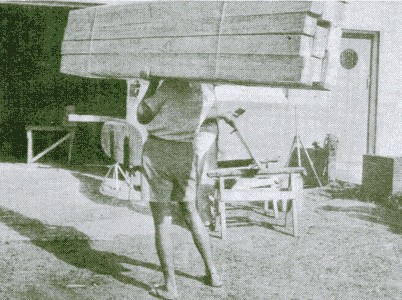 |
Gordon Woods built
his first surfboard in 1941.
During the years
that followed board designs changad gradually until 1956 when the changes
became radical.
That year, American
and Hawaiian surf teams visited our shores and introduced a type of surfboard
unknown in Australia.
The boards were
ten feet long, were made of balsa sheathed in fibreglass and weighed about
25 Ibs. With this equipment they knocked the id, ego and super-ego out
of a whole crowd of our board riders and changed the face of surfing in
the country.
Prior to this,
Australians had been;riding hollow surfboards, 16 feet long, and weighing
anything from 40 to 60 pounds.
The Australian
board was easy to paddle, for it was designed with this in mind, but was
difficult to control on a wave.
In Sydney, the hub of Australian surfing, the Hawaiians started a major revolution in wave riding. They let off the brake and the wheel still ...
Page 23
... hasn't stopped spinning.
At the hub of this new surfing wheel appeared Gordon Woods who with a combination of brilliant design, improvisation and pure surfing knowledge soon established himself as the leading designer-builder and the most progressive authority on short boards in the country.
It was Woods alone
whose appreciation of the situation stopped the revolution from lapsing
into a state of inertia for after the Hawaiians left it was found that
balsa was unavailable in Australia.
This could have
prevented the trend towards short boards from developing but Woods, while
negotiating the purchase of balsa which was not to arrive for another 12
months, began designing a short board made of plywood.
Woods followed
the Hawaiian surf team to Melbourne where he bought a balsa board from
Bob Burnside of Malibu beach, California, for £25.
He used this
board as a model for his hollow prototype.
It was from the
Velsey and Jacobs Californian surfboard shop and was the most advanced
American model.
Now it belongs
to Norm Twight of Collaroy.
Woods finished
his first hollow Malibu board during Christmas, 1956.
It had cedar
and maple sides and was covered by seaply top and bottom. A
fter the fin
was fibre-glassed on it weighed between 35 and 40 pounds.
Compared to a
sixteen foot board it was like getting onto a horse after riding a camel.
It caught on
fast and Woods started making a few for the early fanatics.
In the first
batch Woods made five boards.
They went to
Bob Armstrong of Freshwater, George Simmer and Peter Rose of Queenscliff,
Noel White of Torquay and myself.
As well as the
six hollow boards there were three balsa ones left in Australia by the
Hawaiians.
As well as Woods
hot-dog board, Bob Evans had a speed board and Peter Clare and Bob Pike
shared another one.
At this stage
there were three months of summer left.
The early short
board riders did not have many supporters for the number of boards Woods
could turn out was limited.
As well as this
many hung back because a hollow board looked a very different proposition
to a balsa one.
Everyone was
waiting ... and watching.
Most knew that a new board showed its good points first and that its bad ones didn't become obvious until the first big sea.
However the hollow
Malibu board rapidly became a success.
Its extreme buoyancy
made it very easy to paddle onto a wave and out thtough the surf.
Many of these
boards were made in the year before balsa had become available and board
builders all over Australia copied exactly the brilliant mception that
Woods had developed.
There are riders
who prefer these hollow boards to balsa even now.
|
seen here laying the fibreglass cloth over the balsa wood shape. The Woods' workshop at Freshwater is a popular gathering place for riders. |
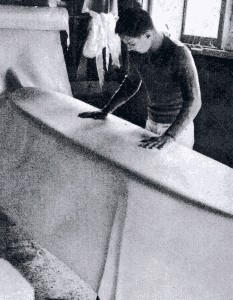 |
With the development
of this board Woods maintained the impetus inspired by the Hawaiians.
Many of the riders
who had the earlier hollow boards now rank among the best ...
Page 24
... board men on the coast.
In some ways the
1956 board was not very far removed in design from the board that Woods
built in 1941.
This board Woods
made of masonite on a kauri wood frame!
It had a square
tail and weighed about 60 pounds!
It was a direct
evolution of the hollow boards which had been used on our beaches since
Hawaiian Olympian Duke Kahanamoku showed Sydney-siders that it was possible
to ride our steep east coast waves on a piece of wood.
This was in 1915.
Kahanamoku used
a piece of Australian sugar-pine which he shaped himself and which Is now
an honour board in Freshwater clubhouse, not far from where Woods builds
his boards now.
After tha Duke
left Australia, board riding progressed slowly.
During the 1930's
when work was scarce and red-wood was cheap, a lot of surfboarding was
to be seen at Bondi and Manly.
Surfers, flung
on the beach by lack of work, shaped boards from large slabs of wood.
In these pre-war
years there were many riders.
Then the war started
and the number of board riders dwindled.
Among Woods'
riding companions prior to the war were Bluey Mayes, Sam Kohen, Ken East,
Zell Frack, Keith Hurst and Ray Hookham.
Woods recalls
that during the war many boards were wrecked by being washed up against
the barb wire and concrete which lined our beaches.
This event had
the nature of a major tragedy because during these years material for building
or repairing boards was almost impossible to get.
Lack of material
was one reason that prevented design development during this period but
at the end of the war board riding began to get back into its stride.
The majority of
riders made their boards on club premises.
Fourteen foot
boards were considered to be very long. the normal length was between ten
and twelve feet.
After a while
14 footers began to get more popular until in 1949 15 footers came into
vogue and then 16 footers in the quest for paddling speed.
Strength was
sacrificed for lightness and wave- suitability became a thing of the past.
During these years
Woods was developing into a leading authority on surfboard design.
He was making
boards for himself and for a few of his friends but he was lending his
advice to whoever asked ... and many did.
He opposed the
tendency to make boards longer and thinner but paddling speed was in vogue
so he waged a passive revolution by the designs of his own personal boards
which were never
extravagantly
long and banana-ed.
It was a far
cry from the solid days when a single, 17/- piece of redwood was the raw
material for a board.
Most of the riding
Woods was doing after the war was at Bondi.
However, from
time to time, the Bondi crowd would pile into an old car, equipped with
a wartime charcoal burner, and head for North Narrabeen.
Once over the
harbour bridge the car would have to take a devious route to get to the
coast for the engine would not pull up the hills around North Sydney.
North Narrabeen
nowadays is one of the favourite short board spots - when a nor-easter
is blowing thewaves stand up on the sandbanks at the north end, a very
long way from the beach.
Woods and his friends would paddle their various types of boards right out to the point and go "sandbank- hopping", much in the style of the balsa boards today.
Late in the war
the Bondi crowd used to take the ferry to Manly when the southerly wind
had closed up their own beach.
Once at Manly
they would try and borrow boards.
During this period
the boards used at Manly were very old-hat.
When Bondi progressed
to 11 foot hollows the Manly boys were still pushIng nine foot solids.
A far cry from
today when Manly is one of the leading board beaches in the State.
But during the
war Manly, Bondi and Palm Beach were the only centres where boards were
to be seen.
After the war,
when boards were becoming longer and longer, Woods contracted rheumatic
fever from winter surfing and was on the shelf for over a season.
Now he Is still
a very cautious winter surfer and doesn't stay out too long on cold days.
During this period
he had plenty of time to mull over the deficiencies of Australian board
design.
He was sure that
the trends were going the wrong way but there was not much he could do
about it -
everyone wanted
the fast-to-paddle boards of the champions and it was very hard to experiment
in the opposite direction.
There were dozens
of misconceived theories about the need of length in Australian surf; some
top-surfers even claimed in the middle '50's that a board only 14 feet
long would fail to get out In a big
sea.
This, from a
champion boardman, prevented most from making a financial experiment towards
shorter boards.
| Woods, with
Bob Evans, co-founder of the recently formed South Pacific Surfriders Club.
Gordon Woods is president, Evans is Secretary. Club has membership of about 250. |
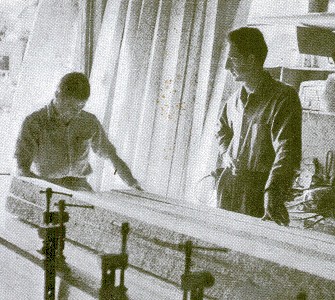 |
Woods began building
boards on a full time basis in 1953.
By this time
there were boards to be seen that were 17 feet long, 17 inches wide and
sporting !O inches of banana.
Going over waves
they resembled giant see-saws.
By 1956, boards
had reached the limit.
Then Hawaiians
showed how wrong we were but there were still a solid core of traditionalists
who refused to believe a short board could handle our Australian surf.
But, as we have
already discussed, Woods realised the potential of the Malibus' and designad
a hollow substitute for balsa, which kept the enthusiasts satisfied until
baIsa arrived late in 1957.
The first balsa
boards that Woods designed had a wide nose and a fairly thin tail, following
roughly the principles embodied in the longer hollows.
They were very
good on a big wave but were not good "hot-doggers".
Woods then developed
a wider-tailed board, known under the confusing title of "hot-dog board',
which still retained the big wave properties of the earlier boards but
incorporated as well the advantages of easy turning.
Woods was turning
out these hot-dog boards when Phillip Hoffman arrived from Hawaii with
the latest Hawaiian design, almost the same as the board Woods had developed.
Phillip was the
brother of Walt Hoffman, one of Hawaii's top big-sea surfers and he and
Woods put their heads ...
Page 25
... together to improve on the already existing hot-dog shape.
In 1958, Woods
saw a photo of the latest Californian development, a pig board, made in
the board making shop of Velsey and Jacobs.
The pig board
was a radical design, breaking away from most theories then in existence.
It had a wide
tail and a tapering nose and was designed essentially for small sea surfing.
It could out-hot-dog
a hot dog board.
Woods began making
pig boards and introduced them to Australia and once again he began making
his own adjustments for Australian conditions.
His boards were
once again an instant success and the advent of the pig board gave the
sport another great push, for they were easy to ride and easy to learn
on.
Now pig-boards
are still the basic equipment though within the pig design there are many
variations, some successful, some not.
As before. most
of the other board builders followed the lead set by Woods.
Today Woods is
still the leading designer-builder of boards in Australia.
He is the man
behind the surfing revolution, the guiding hand and mind that has almost
shaped by itself the trend towards a board that rides a wave like a dream.
Woods has now
built over 1000 short boards: he could build one with his eyes shut, and
few people would dispute that he, more than any other factor, has been
responsible for the giant steps made in the Australian surfing world.
| Boss-man in
front of his premises.
Woods' workshop is typical of board shops allover the world. Walls are lined with pictures of board riders, broken boards and tide charts. |
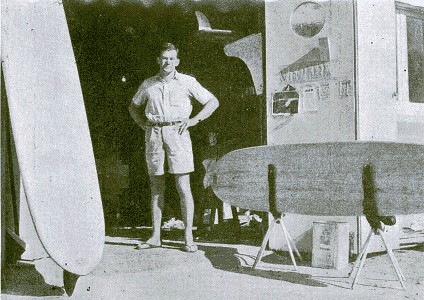 |
|
The Man behind the Surfboard Revolution - Gordon Woods. Australian Outdoors January, 1960, pages 22 to 25. |
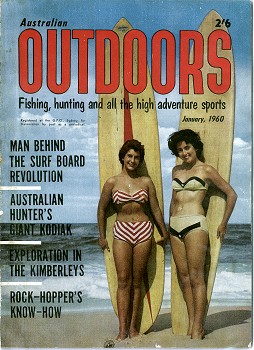 |

| home | catalogue | history | references | appendix |